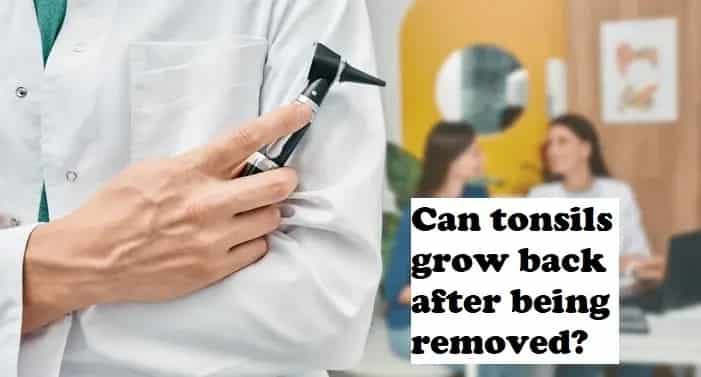“Can Tonsils Grow Back After Being Removed? – Tymoff” Tonsils are small glands located at the back of your throat. They play a role in the body’s immune system by trapping germs that you might breathe in. However, for various reasons such as recurrent infections or significant discomfort, doctors might recommend a tonsillectomy—a surgical procedure to remove the tonsils. Many people believe that once their tonsils are removed, they’re gone for good. But, can tonsils actually grow back after they’ve been surgically removed? This post delves deep into this question, providing a comprehensive understanding of when and how tonsil regrowth might occur.
Table of Contents
Tonsil removal, believed to be a permanent solution to chronic tonsillitis and other related health issues, offers significant relief for many. Yet, the possibility of tonsil tissue regrowing remains a curious topic among patients. Throughout this blog post, we’ll explore the intricacies of tonsillectomy, signs of possible regrowth, and what steps can be taken if regrowth occurs.
Can Tonsils Grow Back After Removal?
“Can Tonsils Grow Back After Being Removed? – Tymoff” While it’s commonly assumed that once tonsils are removed, they’re gone forever, there are rare instances where regrowth can occur. This typically happens when the tonsillectomy doesn’t completely remove all the lymphoid tissue. Pediatric cases are more susceptible to this phenomenon because children’s tissue can be more regenerative. Understanding that tonsil regrowth is not a common occurrence, it’s crucial for patients and guardians to know the conditions that might prompt such a rarity.
Tonsil regrowth is not synonymous with returning symptoms of throat infections. Many factors, such as allergies or new infections, can mimic the symptoms of the pre-tonsillectomy state. If regrowth occurs, it is usually partial and does not always necessitate further treatment. The conditions under which the tonsils were initially removed play a significant role in determining whether a repeat procedure might be required if regrowth occurs.
Understanding Tonsillectomy Procedures
“Can Tonsils Grow Back After Being Removed? – Tymoff“ A tonsillectomy can be performed using various techniques, each with its own specific approach to removing tonsil tissue. Traditional methods involve physically cutting away the tonsils, while newer techniques might use lasers or cauterization. The method chosen can impact the likelihood of any tissue being left behind, which could potentially regrow. It’s essential for patients to discuss with their surgeons the type of tonsillectomy to be performed and understand the implications of each method.
The complete removal of tonsils is the goal during a tonsillectomy; however, no procedure is without the risk of leaving behind minute amounts of tissue. Surgeons aim to balance complete removal with minimizing potential complications. Understanding these nuances helps patients and families set realistic expectations and prepare adequately for post-operative outcomes, including the rare possibility of regrowth.
Signs and Symptoms of Tonsil Regrowth
“Can Tonsils Grow Back After Being Removed? – Tymoff” Identifying tonsil regrowth involves recognizing specific symptoms that might suggest the presence of regrown tissue. Common signs include frequent sore throats or a feeling of fullness at the back of the throat, which could indicate that some tonsil tissue has returned. However, these symptoms can also be due to other throat conditions, making it important to consult healthcare providers for a precise diagnosis.
Seeing visible lumps or tissue in the throat during a routine check-up can also be an indicator of regrowth. If you or your child experiences these symptoms and has previously undergone a tonsillectomy, it’s advisable to seek medical advice. Healthcare providers may use throat examinations or imaging studies to determine if what you’re experiencing is indeed tonsil regrowth.
Treatment Options for Tonsil Regrowth
“Can Tonsils Grow Back After Being Removed? – Tymoff” If tonsil regrowth is confirmed, the treatment options vary based on the severity and symptoms presented. In many cases, no treatment is necessary, especially if the regrowth isn’t causing significant health issues. However, if problems such as recurrent infections, breathing difficulties, or other complications arise, further medical intervention might be required.
Treatment could range from watchful waiting to see if the symptoms resolve on their own, to medication for managing symptoms, or even another surgical intervention in severe cases. Each case is unique, so treatment plans are tailored to the individual’s specific needs, often after a thorough evaluation by an otolaryngologist.
Preventing Complications Post-Tonsillectomy
“Can Tonsils Grow Back After Being Removed? – Tymoff” Post-operative care is crucial in preventing complications and ensuring the best possible outcome after a tonsillectomy. Patients are advised to follow their surgeon’s instructions closely, including taking prescribed medications, managing pain, and adhering to dietary recommendations. Good post-operative care helps reduce the risk of infections and other complications that could lead to issues like tonsil regrowth.
Regular follow-up appointments are essential to monitor healing and catch any potential issues early. These check-ups provide an opportunity to address any concerns and ensure that the recovery process is on track. Preventive measures and timely medical intervention are key components of effective post-operative care.
Conclusion
“Can Tonsils Grow Back After Being Removed? – Tymoff” Understanding whether tonsils can grow back after being removed is crucial for those undergoing or considering a tonsillectomy. While complete regrowth is rare, being aware of the potential for partial regrowth and the signs associated with it can help manage expectations and prompt timely medical consultations if symptoms reappear. Effective post-operative care and regular follow-ups are key in managing any complications and ensuring long-term health benefits from the surgery. If you have any concerns about your tonsils or the recovery process, it is always best to reach out to a healthcare professional who can provide guidance tailored to your specific situation. Remember, every individual’s medical condition is unique, and thus, personalized advice from your doctor is invaluable.
FAQs
Q: Can tonsils fully regrow after being removed? A: No, full regrowth of tonsils after a tonsillectomy is extremely rare. More commonly, small amounts of tonsil tissue may not be completely removed and could potentially regrow, but this regrowth is usually partial and not to their original size.
Q: Does having a tonsillectomy negatively affect the immune system? A: The removal of tonsils does not significantly impact the overall function of the immune system. Tonsils are part of the lymphatic system which helps fight infections, but the body has multiple other components that assist in immune response.
Q: What are the signs that my tonsils might be regrowing? A: Signs of possible tonsil regrowth include recurrent sore throats, a feeling of fullness at the back of the throat, or visible lumps where the tonsils were previously located. It’s important to consult a healthcare provider for an accurate diagnosis.
Q: What should I do if I suspect my tonsils are regrowing? A: If you suspect tonsil regrowth, the best course of action is to consult with a healthcare provider. They can perform a physical examination and possibly imaging studies to determine if regrowth has occurred and discuss appropriate treatment options.
Q: Can adults have their tonsils grow back after removal just like children? A: Tonsil regrowth is more common in children due to their more robust regenerative capabilities, but it is still possible, though rare, in adults. Any regrowth in adults is usually minimal.
Q: Are there any preventive measures to reduce the risk of tonsil regrowth? A: Following the post-operative care instructions from your healthcare provider and attending all follow-up appointments can help monitor healing and catch any irregularities early, potentially reducing the risk of regrowth.
Read More : Natasha Mae Fester Obituary


